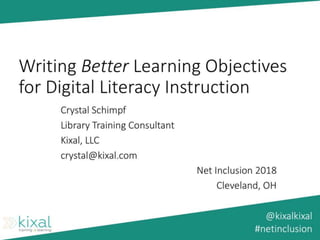
Writing Better Learning Objectives for Digital Literacy Instruction
Notas do Editor
- Hi, my name is Crystal Schimpf. I’m a librarian, instructional designer, and trainer, and I now work as a consultant to libraries and nonprofits. I’ve been designing, delivering, and advising on digital literacy instruction for more than ten years. One thing I’ve observed with many of the libraries and nonprofits I’ve worked with is that we could be doing a better job at writing learning objectives for digital literacy instruction. So that’s what I’m here to talk about today.
- Why should we be concerned with writing better objectives? I mean, we’re teaching technology skills. It’s pretty straightforward, right? Well, if we write better learning objectives we can use them to design better instructional materials, to deliver better training in both individual and group class environments, and we can do a better job of measuring the actual outcomes of our efforts. Ultimately, I think we provide digital literacy instruction to help people change their lives, and to do that, we have to help them change their behaviors, their attitudes, and their beliefs. We aren’t *just* teaching technology skills.
- So what does “better” look like? What makes a “better” learning objective? Well, a typical or common learning objective for digital literacy instruction might be “Teach people how to use email” which isn’t bad. It’s good in that it does identify the goal of the instruction. But a *better* objective would take into account the outcome, the “so what,” the “why” for what it is we are teaching. It takes into account what CHANGE we want to see in people’s behavior, attitudes, or beliefs. So for this example, a “better” objective might be to ”Help people learn to communicate online with family/friends/employers, etc. by using email to send and receive messages. It is more specific to that actions and applications which you intend to teach. To write “better” learning objectives, I recommend following three simple steps, which I’ll share with you now.
- First step: identify the need (or want) of the learner. What is it that the individual wants or needs to be able to do, think, or feel with or about technology? Focus on one specific need or want of the learner, and think about their outcome. Here, we might first point to the technology itself, identifying that the learner needs to use email. That’s good, but let’s make it better. Why do they need to use email? In order to stay connected to family, get in touch with friends, email a potential (or even a current) employer, communicate with a teach (either for their own education, or for their child’s), to take care of business online, or to participate in online discussion groups. These are all valid needs and wants of learners related to using email, and help us focus in more on how we will teach them.
- Second step: Identify a specific skill (or set of skills) that will help the learner to meet their need (or want). Again, here we commonly might say “the learner needs to use email” but that doesn’t really help us focus our instruction. To make it “better,” we can focus on exactly what skills need to be attained in order to be successful at helping the learner meet their need. A few specific skills that might be most relevant are logging into their email account, sending and receiving email, reading email messages and identifying spam, scam, or junk email messages, and deleting unwanted messages.
- Once we’ve identified a learner’s need AND a specific skill, then we are ready to write a ”better” learning objective. Again, we might commonly see a simple learning objective such as “Teach learner how to use email.” But if we get more specific, and include reference to the learner’s *need* and to specific *skills* to meet that need, then we are able to speak to the *outcome* of how they will change their behavior, their attitudes, and their beliefs. In this example, we say we will “Help the learner become more *confident* /communicating with family and friends/ online by *using email* to send and receive messages, read messages, identify spam messages, and delete unwanted email. And what we’ve just done with this learning objective is we’ve outlined our priorities for instruction, so when we design instructional materials we can focus explicitly on these areas. When we deliver training, we can bring that same focus to our instruction in both individual and group environments. And when we go to evaluate the success of our instruction and our outcomes for learners, we know what it is we are trying to evaluate. By writing better learning objectives, we lead to better instructional design, better training delivery, and better measurement of outcomes for learners. Please see me later if you have any questions. Thank you!
